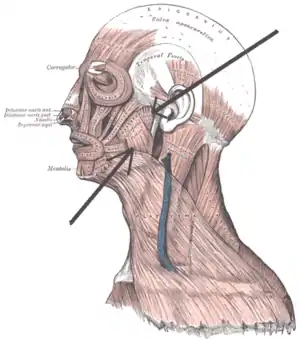Masticatory force
Masticatory force or force of mastication is defined as the force that is created by the dynamic action of the masticatory muscles during the act of chewing.
Masticatory muscles

The muscles that power the jaw movements during chewing are known as the muscles of mastication or masticatory muscles, and are functionally classified as:[1]
- Jaw elevators: the masseter, temporalis, medial pterygoid and superior belly of the lateral pterygoid
- Jaw depressors; the anterior digastrics, geniohyoid, mylohyoid and inferior belly of the lateral pterygoid
Measuring masticatory force
The first device for measuring masticatory force (gnathodynamometer) was created by Black in 1893. He determined that periodontal tissue is an important issue, which impacts the amount of force. Morill found out that masticatory muscles stop their contraction differently upon the appearance of pain signals from the periodontal tissue.[2]
Shreder used local anaesthesia to ignore the periodontal response to measure the maximum force of mastication. His research showed that a 21-year-old man without any periodontal pathology who could produce approximately 35 kilograms-force (340 N) of force, increased the amount of that force to 60 kilograms-force (590 N) following local anaesthesia.[2]
Weber worked out that 1 cm2 surface of perpendicular slide of any masticatory muscle can produce approximately 10 kilograms-force (100 N) force. The following surfaces were found[3]
- temporalis – 8 cm2
- masseter – 7.5 cm2
- medial pterygoid – 4 cm2
Thus, the total average surface area of perpendicular masticatory muscles slide is about 19.5 square centimetres (3.02 in2).
Forces
Nankali studied chewing in multiple individuals. He found variation in the amount of masticatory force.[4]
The masticatory forces changes at eating time according to mouthful characteristic and size. This has various effects on the maxilla and mandible via the teeth. The periodontal system automatically controls the measure of mastication force. The jaw elevator muscles develop the main forces used in mastication.
The force generated during routine mastication of food such as carrots or meat is about 70 to 150 newtons (16 to 34 lbf). The maximum masticatory force in some people may reach up to 500 to 700 newtons (110 to 160 lbf).[1]:156
The study of masticatory force in patients with polymyositis and dermatomyositis shows that hyposalivation and mucosal alterations can be related to the pathology of masticatory system.[5]
Force distribution

Nankali systematized masticatory force distribution.[4] According to this system, force is divided in two main groups, with physiological or pathological conditions. The physiological masticatory force is divided into three subgroups according to their localizations: anterior, general (covering the entire arch) and posterior part of arch, which is also divided into two different groups; unilateral and bilateral.[4]
Producing a maximum masticatory force uses the general subgroup of this systematization.
References
- Scully C (2003). Oxford Handbook of Applied Dental Sciences. Oxford: Oxford University Press. p. 151. ISBN 978-0-19-851096-3.
- Juliev EN, Жулев ЕН (2000). Несъемные протезы: Теория, клиника и лабораторная техника [Fixed prosthesis: Theory, clinic and laboratory technique] (in Russian). Н. Новгород – Novogorad: Nijnegorodskoi Gosudarstveni Medisinskoi Akademi. p. 151. ISBN 5-7032-0330-9.
- Abolmasov NG, Abolmasov NN, Bichkov BA, Alkhakim A (2003). Orthopedicheskaia Stomatalogia. Moscow: Medpress-inform. p. 41. ISBN 5-901712-25-0.
- Nankali A (2002). "Strength Properties Investigation of the hard tissue of the teeth roots". Ukrainian Medical Young Scientists Journal. National Medical University (3–4): 74–76.
- Márton K, Hermann P, Dankó K, Fejérdy P, Madléna M, Nagy G (2005). "Evaluation of oral manifestations and masticatory force in patients with polymyositis and dermatomyositis". Journal of Oral Pathology & Medicine. 34 (3): 164–169. doi:10.1111/j.1600-0714.2004.00280.x. PMID 15689230.
Further reading
- Zhang YR, Du W, Zhou XD, Yu HY (June 2014). "Review of research on the mechanical properties of the human tooth". International Journal of Oral Science. 6 (2): 61–9. doi:10.1038/ijos.2014.21. PMC 5130056. PMID 24743065.